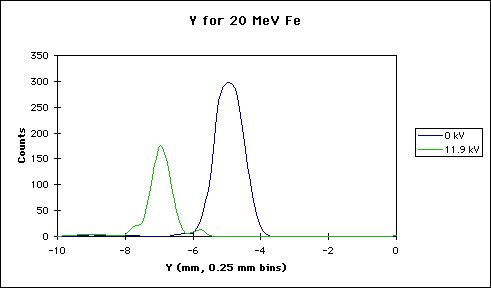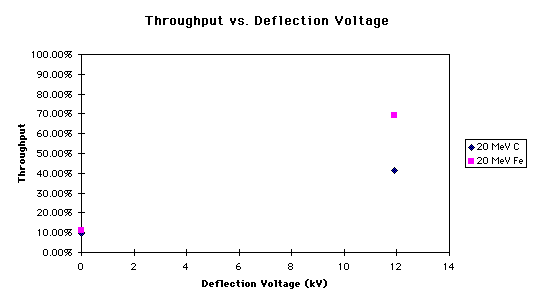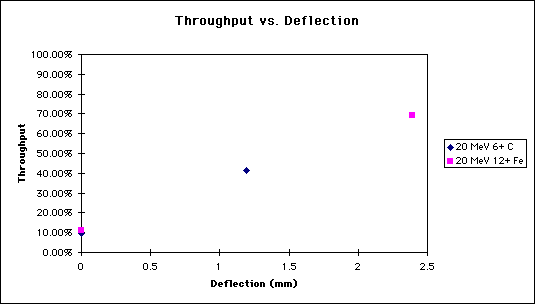Data Analysis
Our job is to analyze test results from the SEPICA in order to better
understand what is going on inside the instrument.
Recently, some questions have arisen:
-
How do we obtain the greatest throughput of particles?
-
How can the particles avoid hitting the ceramic SSD support?
Throughput:
There are two factors that we thought might
affect the throughput of particles. The throughput is the percentage of
particles that are completely identified out of the total particles that
enter the machine. These two factors are the voltage of the center plate
and the energy of the particles. Many particles are not identified because
they crash into a ceramic plate within the instrument. A higher voltage
should deflect the particles away from the ceramic, while a less energetic
particle should allow for more deflection.
To test these hypotheses, we ran the data files of tests
for which we knew the energy of the particles and the voltage of the center
plate.
To determine how voltage affects throughput, we compared:
Voltage:
20 MeV Carbon at -0kV Throughput=9.5%
-11.92kV Throughput=41.4%
20 MeV Iron at -0kV Throughput=11.1%
-11.92kV Throughput=69.0%
FIGURE A

FIGURE B

FIGURE C

Figure A:
This is the footprint of
the beam in the instrument after going through the collimator. The purple
trace is undeflected and the green trace has been shifted to the left,
further on to the Solid State Detector surface. The purpose of the deflection
is to determine the charge to energy ratio (Q/E) of the particle. We used
the SSD to measure the energy (E) of the particle. With these two pieces
of information, we can calculate the charge (Q) of the particle.
Figure B:
Throughput vs. Deflection
Voltage for carbon and iron beams.
Figure C:
Throughput vs. Beam Deflection
(mm) for carbon and iron beams. 70% is the maximum expected throughput
for the particles because of necessary supporting structures inside the
intrument.
Additional Data:
25 MeV Iron at 11.92 kV Charge State=12+ Throughput=69.0%
60 MeV Iron at 11.92 kV Charge State=12+ Throughput=49.5%
Conclusion
: For lower energy per
charge particles, such as 20 MeV carbon and iron, a higher voltage produces
a higher deflection, allowing the particles to avoid the ceramic support,
and thus producing a higher throughput. For these two beams, we had to
move them about their footprint's width (Figure A) to get maximum throughput.
According to the iron data, it seems that for higher energy
per charge particles, the deflection is lower, resulting in more particles
colliding with the ceramic SSD support, and therefore a lower throughput.
Running
Tests
Back to home
